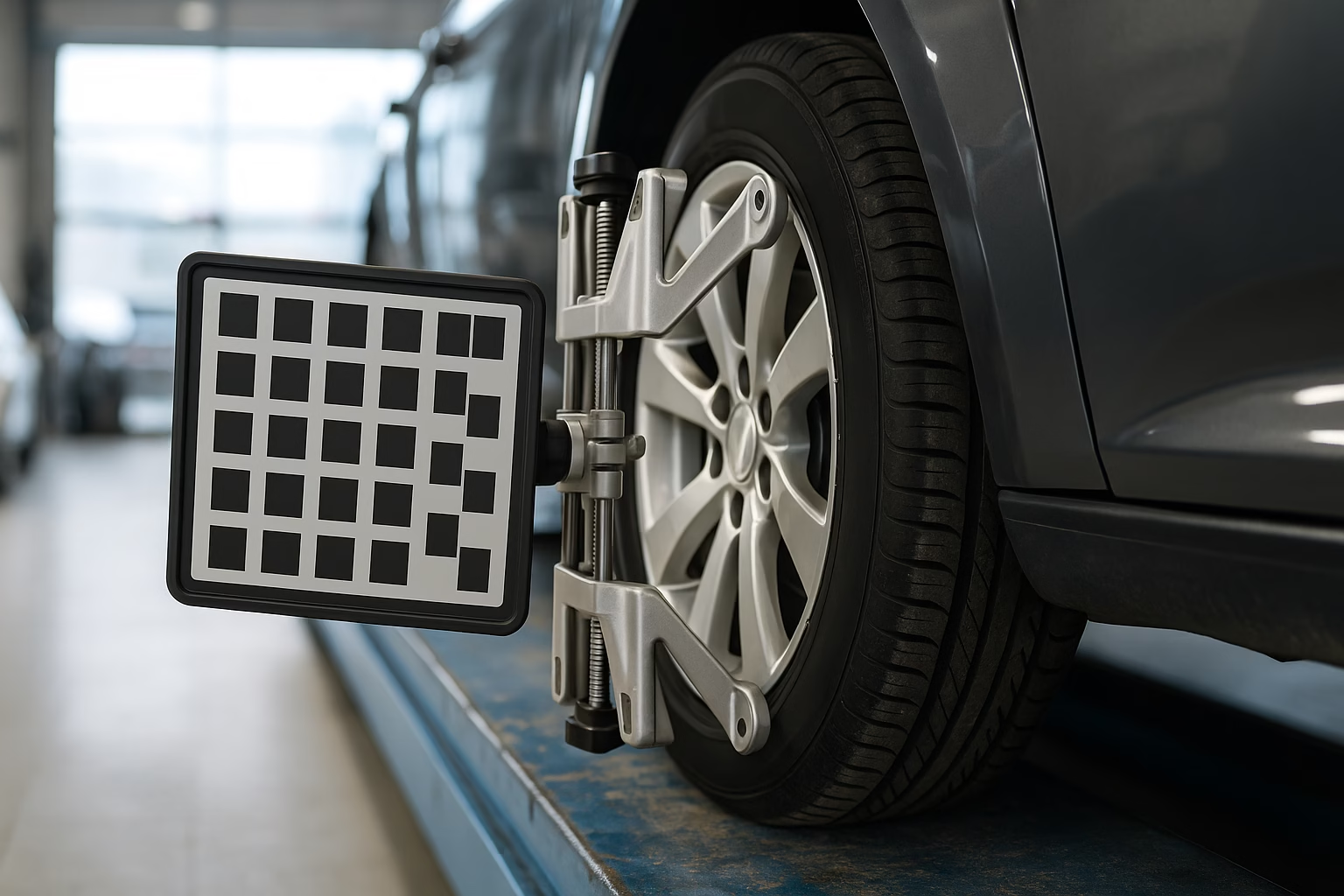In modern vehicles equipped with advanced driver assistance systems (ADAS), a simple wheel alignment check is no longer just about tyre wear and steering feel. Proper alignment is one of the foundations that keeps cameras, radar modules and other sensors pointing in the correct direction so that assistance features like lane following assist, adaptive cruise control and automatic emergency braking can interpret the world accurately. As Ryan Gerber notes in Modern Tire Dealer, “almost every ADAS calibration begins with an alignment because if the wheels aren’t straight, neither is the ADAS.” He explains that radar and camera beams act like a torch – a slight change at the wheel becomes a large mis-aim at 50 metres . Without proper alignment, the vehicle may drift in its lane and the sensors will be looking at the wrong road markings, causing features to intervene incorrectly.
How misalignment affects ADAS sensors
Wheel alignment refers to the angles and position of the wheels relative to each other and the vehicle. Key measurements include camber (the tilt of the wheel), toe (whether the front of the wheels point in or out) and caster (the angle of the steering axis). When these angles are within manufacturer specifications, the car tracks straight and the steering wheel sits level. More importantly for ADAS, the cameras and radar units mounted behind the windscreen, in the front bumper and in side mirrors rely on the vehicle moving straight ahead. If toe or camber is off by even a fraction of a degree, the ADAS modules may not be aimed at the centre of the lane. The result can be lane departure warnings when the car is centred, false alerts when following a vehicle and poor automatic braking performance. The Activate Group cautions that sensors knocked out of position by minor collisions or repairs can cause safety features to stop working or intervene when they shouldn’t . Misaligned wheels introduce the same problem by turning the chassis away from where the sensors are looking.
Causes of misalignment
Many everyday events can throw alignment out. Hitting potholes or kerbs, carrying heavy loads, or driving at speed over speed bumps can bend suspension components. Worn ball joints, bushings and tyres allow angles to shift gradually over time. Aftermarket modifications such as larger wheels, lowering springs or lift kits alter the suspension geometry, while towing heavy loads can temporarily change ride height. Even minor bodywork repairs can disturb alignment. Technicians should always perform a wheel alignment after any suspension or steering work and after fitting new tyres or wheels. The MRT Auto Clinic notes that ADAS calibration is often needed after tyre changes, suspension repairs or software updates , which underscores the close relationship between alignment and sensor calibration.
Which ADAS features are affected?
Lane keeping and lane following assistance systems use a camera to read lane markings and determine the car’s position. If the alignment is off, the car may physically be in the centre of the lane while the camera and steering control module think it is closer to one side, triggering unnecessary steering correction. Adaptive cruise control and forward collision warning rely on a radar sensor to measure the distance and speed of vehicles ahead. A mis-aimed radar will see vehicles in adjacent lanes or the roadside instead of the lane ahead, leading to harsh braking or loss of assistance. Automatic emergency braking may apply the brakes when there is no hazard, and blind-spot monitoring may give false positives if the vehicle drifts within its lane. The Modern Tire Dealer report explains that misalignment near the wheel multiplies at distance, so a 0.5-degree misalignment can translate to several metres off target down the road . That is why proper alignment is fundamental before any calibration.
When to align and calibrate
A good rule of thumb is to check alignment at least once a year or whenever a driver notices the vehicle pulling to one side. Technicians should check alignment after any suspension or steering repair, wheel or tyre change, or when ride height is adjusted. After aligning the wheels, they should perform an ADAS calibration to ensure the sensors are aimed correctly. Dynamic calibrations require driving the vehicle at steady speeds on well-marked roads while the scan tool learns the new sensor positions, and static calibrations use fixed targets in the workshop. Both methods depend on the wheels being straight and the steering angle sensor being zeroed. Modern Tire Dealer notes that dynamic calibrations can be performed with a scan tool and a road test, while static calibrations require more equipment and space . Without the preliminary alignment, either calibration method will be off.
Best practices for technicians
When aligning ADAS-equipped vehicles, follow manufacturer specifications for camber, caster and toe. Use properly calibrated alignment equipment and confirm tyre pressures and ride height first. After alignment, reset the steering angle sensor and perform a complete ADAS calibration using OEM-approved targets, scan tools and procedures. Always test drive the vehicle after calibration, confirming that lane departure warnings and cruise control operate smoothly and warning lights are off. Document the alignment measurements and calibration results for insurers and customers; this not only protects your workshop but demonstrates that the vehicle’s safety systems function as intended.
Conclusion
Wheel alignment is more than a tyre maintenance task – it is a critical step in maintaining the accuracy of advanced driver assistance systems. Even small misalignments can magnify sensor errors, leading to false warnings or missed hazards. By checking alignment regularly, performing it after repairs and modifications and always calibrating ADAS sensors afterwards, technicians ensure that features like lane keeping assist and adaptive cruise control work reliably. For drivers, this means a smoother, safer experience and confidence that the technology helping them on the road is seeing the same road they are.

Hiran Alwis is an automotive lecturer and ADAS specialist with over 15 years of experience in diagnostics, advanced safety systems, and technical training. He founded ADAS Project to help everyday drivers and workshop technicians understand and safely use advanced driver assistance systems.
